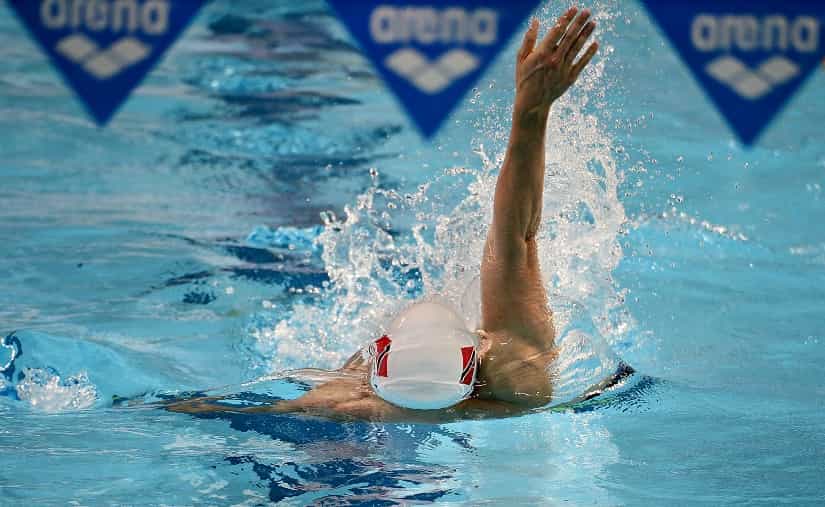
7 Best Swim Snorkels for Better Technique and Faster Swimming
Ready to throw down on a new swimmer’s snorkel? Here are reviews of the best swim snorkels for lap swimming.

The swim cap is one of the more misunderstood pieces of swim gear. Here’s what you need to know about picking out the perfect cap for swimming.
When it comes to swimming gear the swim cap can seem a little confusing.
After all, you put it on your head…but it doesn’t keep your hair dry. They are made of different materials. And of course, there is the overall look and sizing of the caps.
Here’s what you need to know about picking out the perfect swim cap so that you can crush your swims in comfort.
Most competitive swim caps are made of latex. It’s the cap that is most used from the age group levels and up. The reason is simple—they are cheap, relatively durable, and are also breathable.
That being said, swim caps are also made in a couple other formats, most notably with competitive swimmers, silicone. (Which you will also find in swim goggle straps and even on the inside of tech suits and jammers which help swimmers pull them on without ripping the delicate fabric the suits are made of.)
Just about every swim cap made for competitive swimming is silicone or latex.
Your cap choice should depend on the kind of training you do, how often you train, and the pool temperature.
The Benefits of Silicone swim caps:
They are soft, and therefore better suited for swimmers who have a fair amount of hair on their melons. The cap won’t tug or rip at your head and hair. Because they don’t stretch very much, silicone caps also last a long time.
Silicone caps also don’t have as much surface area, and don’t wrinkle at the back and top of your head giving both a superior fit, and also a more hydrodynamic fit.
They are also generally considerably more expensive than latex caps.
The Benefits of Latex swim caps:
Latex caps are cheaper and more breathable than their silicone counter-parts.
Because they are thinner, they provide better ventilation of heat you’re your head while you are training your butt off in the pool.
We’ve all trained in that pool that is ten degrees warmer than it should be, leaving us visibly sweating and red-faced. Having a thick (silicone) cap on our heads only makes this over-heating worse.
On the other hand, they don’t last well when unattended. Let’s be honest here—there are more times than you can count that you’ve left your gear to rot at the bottom of your swim bag for a week or longer.
So what happens you finally do go check on it? It’s mashed up, sticky, and nearly melted together.
What about Lycra caps?
While competitive swimmers almost exclusively wear silicone or latex on their melons while training and racing, there is a third type of cap that is more suitable for less competitive activities in the water.
If you are looking for a cap solely for keeping your hair dry during water exercise such as water jogging or water jazz-ercise, consider getting a cap that is made mostly of Lycra.
They will provide you the benefits of keeping your hair dry while also keeping your head cooler than caps are made for competitive swimmers that are composed of silicone or latex.
Lycra or Spandex caps are also handy for competitive swimmers in terms of wearing it underneath their racing caps (usually silicone). Speedo and FINIS both produce caps for this purpose.
Lastly, there are also neoprene swim caps. These thicker (around 3-4mm) caps are made from the same material as wet-suits. Neoprene swim caps are designed to keep your head warm while swimming in open water.
Here’s some of the more common questions I get from swimmers and swim parents when it comes to picking out a cap for swimming.
Do I have to wear a cap?
Absolutely not. Totally up to you. But there are some good reasons to wear a swim cap. That being said, tuck your hair back. Nothing more annoying than swimming across the pool and having a big slab of hair slide across your goggles, blinding you. On days at my local YMCA where the pool temperature is higher than usual, I prefer to swim without one.
Will a swim cap keep my hair dry?
This will surprise most newbie swimmers—no. Swim caps, although tight and fancy-looking, don’t provide a water-tight seal around your head. Water will get in there, so keeping your hair completely dry while swimming is not gonna happen.
So why wear a cap at all?
It does keep your hair *mostly* out of the chlorine from swimming pools, keeps your hair out of your face, and also helps provide some hydrodynamic benefit as well.
It’s also just good form by keeping your hair from falling off your head and collecting at the bottom of the pool. There’s nothing worse than enjoying a good session in the pool and then having a meatball of tangled-up hair hurtle into your face.
Keeping hair out of the pool helps to keep it cleaner for everyone involved.
You can make your swim cap last a particularly long time with some very basic maintenance.
#1: Rinse it with cold water.
A simple rinse with fresh water after each dip into the pool will help extend the shelf life of your swim gear, and your cap is no exception.
Rinsing the chlorinated water off the cap takes about five seconds, and can be done in the shower, or when rinsing out your swim suit after practice.
#2: Dry it outside your swim bag.
I get it–your workout is over, you are tired, and the last thing you want to do is empty out your swim bag.
With latex caps in particular, taking it out of your damp bag and letting it air dry will dramatically increase the lifespan of your cap.
#3: Baby/Talcum powder.
For added care, and particularly for you swimmers who go a fair amount of time between sessions in the pool, when you get home, and the cap is mostly dried out, sprinkle some baby powder or talcum powder inside the cap.
It will help to absorb any residual moisture and keep your cap nice and supple. (This tip does not work for spandex or lycra caps, by the way.)
If you find that there is mold growing in the cap, you can try to clean it out with bleach and water, but this will also risk degrading the cap.
Additionally, if you find a hole in the cap, it’s time to get a new one. Holes stretch quickly, particularly when you try to pull it over your head.
Subscribe to the YourSwimLog.com newsletter and get tips and advice on how to swim faster every weekday morning, straight to your inbox.
Join 33,000+ swimmers, coaches, and swim parents learning what it takes to swim like a boss.
Unsubscribe anytime. Email will never be shared or sold.

Olivier Poirier-Leroy Olivier Poirier-Leroy is the founder of YourSwimLog.com. He is an author, former national level swimmer, two-time Olympic Trials qualifier, and swim coach.

Ready to throw down on a new swimmer’s snorkel? Here are reviews of the best swim snorkels for lap swimming.

Looking to get some new swim gear on a budget? Shop the best Black Friday deals for swimmers in this exclusive guide.

Looking for the best swimming app to maximize your time and effort in the water? Here’s a look at the top swim apps for conquering your swim workouts.

Wondering how often you should be testing the water in your pool or spa? Here’s a detailed look at how frequently you should test your pool. Your swimming pool and spa relies on being properly balanced to keep the water clean and safe for swimming. As a pool owner, you

Fed up with the effects and smell of chlorine in your hair after swimming? Here is how to remove chlorine from your hair once and for all.

The DMC Elite fins are high-performance training fins for competitive swimmers. Here’s a review of why these fins are flat-out awesome.

LANE 6 PUBLISHING © 2012-2024 · PRIVACY POLICY · RETURN POLICY · TERMS OF SERVICE · AFFILIATE DISCLOSURE